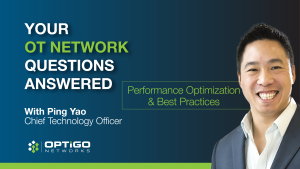For years, it was easy to operate building automation (and most building systems) under the assumption that “if nothing seems wrong, nothing is wrong.” However, this belief can be misleading and dangerous. Minor, unnoticed anomalies can (and do) compound over time, turning minor issues into major disruptions that affect operational efficiency and compromise security.
In other words, your OT network might be teetering on the verge of collapse right now… you just can’t see it.
Let’s explore how limited network visibility can hide critical issues. We’ll delve into various potential pitfalls—from security breaches and misconfigurations to hardware failures and performance blind spots—and discuss how enhanced network visibility allows organizations to detect issues early, paving the way for proactive maintenance and swift remediation.
1. Performance Blind Spots: When Slowdowns Turn Catastrophic
Probably the most common reasons why OT networks eventually fail, and the ones we harp the most about, are the small issues that compound over time. Whether it’s MS/TP or BACnet/IP, the results are the same: Limited network visibility often means missing the obvious signs of mounting performance issues.
Here’s how performance blindspots can wreak havoc:
Unnoticed slowdowns or bottlenecks
When resource allocation or network health isn’t monitored closely, small performance issues can go undetected until they become bottlenecks. These slowdowns have dozens of causes—inefficient routing, poor load balancing, or the overuse of certain network segments—that wouldn’t be obvious unless you were measuring for them. Over time, they can even cause data integrity issues that affect system reliability.
As with most bottlenecks, these issues tend to compound down the line, leading to significant delays, and eventually, dropped data packets. Without granular data on usage patterns, organizations might over- or under-provision their network resources. Over-provisioning wastes valuable resources and increases costs, while under-provisioning leads to inadequate support for critical operations, potentially causing system outages.
Loss of data integrity
In environments where real-time data is crucial—such as manufacturing or energy management—any delay or degradation in network performance can result in poor data quality and data integrity issues. This, in turn, affects decision-making processes and can lead to significant operational risks.
Compromised data integrity in OT networks can lead to significant disruptions, safety risks, and increased costs. Inaccurate data can cause building systems to malfunction—faulty temperature sensor readings, for example, may result in reducing occupant comfort and driving up energy waste. Erroneous data from security sensors can lead to unauthorized access or missed intrusion detection, putting building occupants at risk.
Data inaccuracies can cause inefficiencies that increase energy consumption and maintenance costs, straining operational budgets and reducing overall system reliability.
We’ve looked at the underappreciated value of data integrity, and how the lack of visibility into the quality of the data on your network can easily lead to bad decisions by automation throughout your entire facility.
Unidentified interdependencies
In an OT network environment, unidentified interdependencies can be particularly troublesome and difficult to diagnose without the right tools. These are hidden links between systems that, if disrupted, can lead to widespread operational failures. Consider a modern office building where an OT network manages HVAC, lighting, and security systems. Each of these systems are interconnected and communicate in specific ways that may not be obvious without either long standing experience on that particular network (and that shrinking talent pool is taking all that knowledge with them) or deep network visibility.
One example could be a building’s access control and its HVAC system. Imagine the access control system experiences an unnoticed network issue. If this system stops reporting occupancy data, the HVAC system may not receive the correct signals to adjust airflow and temperature dynamically. You can imagine what kind of outcomes that can lead to.
Another example might involve a pharmaceutical manufacturing facility’s HVAC system, which may also provide essential cooling for the server rooms that host the SCADA system. If the HVAC system experiences a malfunction and its issues go undetected due to limited visibility, the server rooms could overheat. The resulting thermal stress might then cause the SCADA servers to slow down or even shut down unexpectedly. This cascade effect—from a seemingly unrelated subsystem—can lead to a full-scale disruption in the manufacturing process, halting production and potentially causing damage to critical equipment and millions of dollars in lost revenue.
Without a comprehensive understanding of all your system interconnections, organizations remain unaware of these vulnerabilities until a minor failure escalates into an operational disruption.
2. Hardware Failures: The Overlooked Risks
Even with the best software and cybersecurity measures in place, hardware failures remain one of the most challenging issues to detect without proper network visibility. Here’s why:
- Deteriorating Equipment Performance: Hardware components, like sensors, switches, and routers, degrade over time. Without continuous monitoring, early signs of hardware failure—such as intermittent performance issues or subtle declines in output—can go unnoticed, eventually leading to complete system breakdowns.
- Overload: Legacy hardware won’t keep pace with the modern demands of OT network traffic. That can cause inefficient routing or load balancing, leading to bottlenecks and slowdowns that affect the entire network. This inefficiency is often difficult to pinpoint without detailed performance data.
- Data Latency and Integrity Issues: Hardware malfunctions also contribute to data latency and data integrity issues. In settings where real-time decision-making is critical, even a minor hardware failure can have repercussions on overall system performance.
- Delayed Detection and Replacement: Without robust monitoring systems, hardware issues may not be identified until they manifest as critical failures. This delay in detection can mean longer downtimes, increased maintenance costs, and a higher risk of operational disruptions.
3. Security Issues: More Than Just Cyber Threats
OT networks were never envisioned to be connected to a larger, worldwide network of connected devices. They are uniquely vulnerable to attack. That’s why it’s vital that teams, typically under the IT department, have a full understanding of what the OT network comprises, so they can include it under their security umbrella. You can’t protect what you can’t see, and that once again means focusing on the network visibility as a first step to securing your network.
Without a clear understanding of what’s on your OT network, where and how it connects to other networks, the risks are many:
Undetected Malware and Persistent threats
Leaving an open port to the web that no one knows about, for example, is an easy way for a malicious actor. Undetected malware can linger within a network, quietly collecting data or sabotaging system processes. Advanced persistent threats (APTs) can infiltrate your system and operate for long periods without triggering any alerts. Without robust monitoring tools, these stealthy actors might not be discovered until significant damage has been done.
Poorly configured networks, including inadequate segmentation, create blind spots that can allow attackers to move laterally within your systems. Even if one segment is compromised, a lack of proper network segmentation can enable attackers to gain access to more critical areas.
Rogue assets
Also known as a “man in the middle” attack, unauthorized or unrecognized devices can slip into your network and hijack data or requests to their own destinations. But what’s important to know is it doesn’t have to be a foreign device. That controller you replaced but never actually removed from the network? It could easily be repurposed. Or those laptops OT technicians use to connect to the OT network or BAS, but IT has no control over (what’s known as “shadow IT”) could easily be rouge hardware waiting to inject malware.
Whether due to shadow IT practices or malicious intent, rogue assets create vulnerabilities that can be exploited by attackers, leading to potentially disastrous outcomes. This is where visibility, in the form of an up to date asset inventory, allows your security pros to set up measures to limit access to areas and devices.
Zero-day exploits
When devices or systems remain unpatched, they become susceptible to zero-day exploits—vulnerabilities unknown to the vendor but actively exploited by hackers. Again, network visibility must include a robust asset inventory or proactive maintenance routine that can help identify hardware in need of updates.
4. Beyond the Breakdown: Compliance and Configuration
Serious problems with your OT network’s operation don’t necessarily have to culminate with everything going offline. Sometimes, like with compliance failures or configuration drift, the ramifications only become evident when you finally look, and not because an offline event caught your attention.
Compliance and reporting
Compliance is a factor in many industries these days—with rules ranging from privacy and data handling, to security and disclosure. That means being able to share logs of activity, or proof of certain steps taken have to be complete and auditable. Without deep visibility into your network, and the ability to capture that activity properly, your compliance and reporting abilities are going to fall short. For example:
- Many regulatory standards require detailed logging and reporting of network performance and security events. Without proper visibility, discrepancies may go unnoticed, leaving organizations exposed to fines, legal repercussions, or even shutdowns.
- In the event of an audit or incident investigation, having an auditable diagnostic history is invaluable, especially when proving that no data integrity issues occurred during critical operations. Limited observability makes it difficult to reconstruct events or prove that systems were being monitored correctly, potentially leading to compliance failures.
Proactive monitoring and a robust compliance framework can help ensure that all aspects of your network operations are transparent, traceable, and in line with regulatory requirements.
Configuration drift
Configuration drift occurs where systems gradually deviate from their originally approved configurations. Since most BACnet devices require manual commissioning and configuration updates, this can be particularly common.
Configuration drift can happen for several reasons, and introduce a host of issues:
- In many organizations, routine updates, patches, or even ad hoc modifications can occur without proper documentation. Over time, these untracked changes can lead to a configuration drift that introduces operational inconsistencies or conflicts that lead to programmatic or operational failures.
- Small errors in configuration might seem insignificant on their own, but when combined, they can impact the interoperability between different systems and introduce data integrity issues. For example, if the settings on a critical sensor in an OT system drift from the optimal configuration, it might lead to inaccurate data readings, affecting real-time decision-making.
By implementing continuous monitoring and automated configuration management tools, organizations can detect and address configuration drift before it turns into a significant operational issue.
Solving OT Data Integrity Issues with OptigoVN
One of the most effective ways to mitigate these hidden issues is by enhancing network visibility and observability through specialized tools like OptigoVN with a Site Scope+ advanced diagnostics add-on. With comprehensive, real-time visibility into the performance and health of each device and the network itself, OptigoVN is designed to help move away from a reactive “break/fix” model to a more proactive approach to network health monitoring and maintenance. Here’s how:
Unrivaled visibility into OT networks
OptigoVN provides comprehensive insights into your OT network, giving you a clear picture of all connected devices and their status. This level of visibility is critical for detecting even the smallest anomalies before they escalate.
Device-level diagnostics
With 29 different diagnostic tests available, OptigoVN offers deep insights into device performance and health. These tests help uncover issues that might otherwise remain hidden, allowing for prompt remedial action.
Enhanced context with Site Scope+
Site Scope+ offers detailed insights beyond standard diagnostic results. It provides critical context by comparing results against recommended ranges, offering device-specific details that you won’t find with other on-the-market solutions. This level of granularity is essential for identifying and addressing issues before they become catastrophic.
Collaboration and sharing capabilities
The ability to share diagnostic results with system integrators, colleagues, and vendors streamlines the troubleshooting process. This collaborative approach ensures that problems are addressed from multiple angles, enhancing overall network stability and performance.
Actionable health scores at a glance
With real-time network health scores, decision-makers can quickly grasp the state of their network. These scores provide actionable information that helps prioritize responses and focus on the most critical issues first.
Continuous monitoring for real-time alerts
Continuous monitoring means that performance issues or operational anomalies are detected as soon as they occur. This real-time identification allows for swift intervention, preventing minor issues from turning into major failures.
Auditable diagnostic history for root cause analysis
In the event of an issue, having an auditable diagnostic history is invaluable. It enables quick root cause analysis, helping teams understand the origin of a problem and preventing unscheduled downtime. This proactive approach not only saves time and resources but also minimizes the risk of recurring issues.
Want to see what OptigoVN can fix for you? There’s never been a better time to get started with the industry’s most powerful OT network diagnostic tool. Sign up for a free trial of OptigoVN today or contact us to schedule a personalized demo and see how our platform can empower your team.

Frequently Asked Questions
1. What are common hidden issues in OT networks?
Hidden issues in OT networks include performance blind spots, data integrity issues, configuration drift, hardware degradation, and unidentified interdependencies between systems.
2. How do performance blind spots affect building operations?
Blind spots can cause unnoticed slowdowns, data packet loss, and resource bottlenecks. Over time, these issues compound and lead to outages or poor system performance.
3. What causes data integrity issues in OT environments?
Data integrity issues can result from degraded hardware, misconfigured devices, delayed updates, or network congestion. These issues compromise decision-making and system reliability.
4. Why is network visibility critical for OT system reliability?
Without visibility, you can’t detect or diagnose problems before they escalate. Tools like OptigoVN provide the real-time insights needed for proactive maintenance.
5. How do unidentified interdependencies cause failures?
If one system depends on another without clear visibility, a small failure (like a sensor misreading) can cascade across the network and impact unrelated systems.
6. Can outdated or unmonitored hardware lead to system downtime?
Yes. Without monitoring, gradual hardware deterioration can go unnoticed until it causes a critical failure, resulting in costly downtime.
7. What is configuration drift and why is it risky?
Configuration drift happens when device settings change over time from their original configurations. It can lead to system instability, conflicts, or non-compliance.
8. How does network visibility help with compliance and auditing?
Visibility tools log activity and provide an auditable diagnostic history, making it easier to prove compliance and investigate incidents.
9. What role do rogue assets play in OT security risks?
Rogue assets—whether malicious or unintentional—can introduce vulnerabilities. Network visibility helps identify and isolate unauthorized devices quickly.
10. How can OptigoVN help mitigate these hidden network problems?
OptigoVN with Site Scope+ offers real-time diagnostics, device health scores, and detailed visibility to detect and resolve issues before they escalate.
*FAQs are created with the assistance of generative AI





